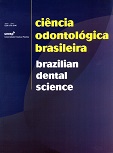Influência da ovariectomia na atrofia e regeneração da glândula parótida: estudo
DOI:
https://doi.org/10.14295/bds.2003.v6i4.573Abstract
A proposta deste trabalho foi estudar morfologicamente em ratas os efeitos da ovariectomia na atrofia e regeneraçãoda parótida. Foram utilizadas 56 ratas divididas em dois grupos: grupo controle A (ratas não ovariectomizadas)
e grupo experimental B (ratas ovariectomizadas). Aos três meses de idade, as ratas do grupo B foram
ovariectomizadas e as do grupo A sofreram falsa-ovariectomia. A atrofia e regeneração da parótida foram estudadas
em ambos os grupos, sendo a atrofia obtida através da ligadura do ducto excretor e a regeneração, através
da desobstrução ductal. Os animais foram sacrificados um mês após falsa-ovariectomia ou ovariectomia e nos
períodos de sete dias de atrofia glandular e de sete e 14 dias de regeneração glandular. As parótidas removidas
cirurgicamente foram submetidas às colorações de HE e PAS. Após falsa-ovariectomia e ovariectomia, as ratas
dos grupos A e B, respectivamente, apresentaram os mesmos aspectos morfológicos. Durante a atrofia glandular,
houve redução do parênquima, assim como inflamação, fibrose e diminuição de grânulos de secreção nos grupos
A e B. Durante a regeneração glandular, houve o restabelecimento do parênquima, redução da inflamação e da
fibrose e aumento dos grânulos de secreção em ambos os grupos. Porém, aos sete dias de regeneração glandular,
as parótidas das ratas do grupo B apresentaram menor grau de regeneração, o qual foi restabelecido aos 14 dias.
Conclui-se, portanto, que a ovariectomia não altera morfologicamente a parótida normal e não influencia o
processo de atrofia glandular, porém retarda o processo regenerativo glandular em sua fase inicial.
Downloads
Downloads
Published
How to Cite
Issue
Section
License
Brazilian Dental Science uses the Creative Commons (CC-BY 4.0) license, thus preserving the integrity of articles in an open access environment. The journal allows the author to retain publishing rights without restrictions.
=================




























